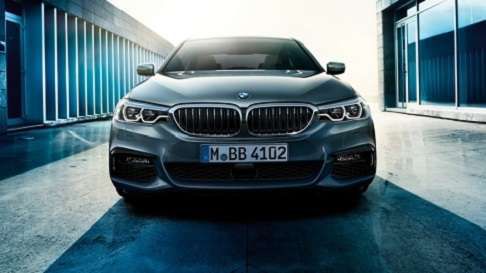Our tool for managing your permission to our use of cookies is temporarily offline. Therefore some functionality is missing.

THE X5
BMW X5: ENGINES & TECHNICAL DATA
Discover the powerful petrol, diesel and hybrid engines as well as the dimensions and other technical data of the BMW X5.
Discover the powerful petrol, diesel and hybrid engines as well as the dimensions and other technical data of the BMW X5.
BMW X5: TECHNICAL DATA.
- BMW X5 xDrive40i (4)
- BMW X5 xDrive30d
- BMW X5 M50d
No search result found. Please try another input

| Unladen weight EU in kg | 2.135 |
|---|---|
| Max. permissible weight in kg | 2,800 |
| Permitted load in kg | 765 |
| Permitted axle load front/rear in kg | 1,280/1,580 |
| Luggage capacity in l | 650 |
| Trailer load 8% (braked) in kg | 2,700 |
| Cylinders/valves | 6/4 |
|---|---|
| Capacity in ccm | 2,998 |
| Stroke/bore in mm | 94,6/82,0 |
| Engine power in kW (PS) at 1/min | 250 (340)/5,500-6,500 |
| Engine torque (Nm) at 1/min | 450/1,500-5,200 |
| Compression ratio : 1 | 11.0 |
| Top speed in km/h | 243 |
|---|---|
| Acceleration 0–100 km/h in s | 5.5 |
| Urban in l/100 km | 11.2 |
|---|---|
| Extra-urban in l/100 km | 8.1 |
| Combined in l/100 km | 9.2 |
| CO2 combined emissions in g/km | 211 |
| Tank capacity, approx. in l | 83 |
| Unladen weight EU in kg | 2.185 |
|---|---|
| Max. permissible weight in kg | 2,860 |
| Permitted load in kg | 770 |
| Permitted axle load front/rear in kg | 1,320/1,615 |
| Luggage capacity in l | 650 |
| Trailer load 8% (braked) in kg | 1,900 |
| Cylinders/valves | 6/4 |
|---|---|
| Capacity in ccm | 2.993 |
| Stroke/bore in mm | 90.0/84.0 |
| Engine power in kW (PS) at 1/min | 195 (265)/4,000-4,000 |
| Engine torque (Nm) at 1/min | 620/2.000-2.500 |
| Compression ratio : 1 | 16.5 |
| Top speed in km/h | 230 |
|---|---|
| Acceleration 0–100 km/h in s | 6.5 |
| Urban in l/100 km | 7.7 |
|---|---|
| Extra-urban in l/100 km | 6.7 |
| Combined in l/100 km | 7.0 |
| CO2 combined emissions in g/km | 185 |
| Tank capacity, approx. in l | 80 |
| Unladen weight EU in kg | 2.35 |
|---|---|
| Max. permissible weight in kg | 3,010 |
| Permitted load in kg | 820 |
| Permitted axle load front/rear in kg | 1,395/1,670 |
| Luggage capacity in l | 650 |
| Trailer load 8% (braked) in kg | 2,700 |
| Cylinders/valves | 6/4 |
|---|---|
| Capacity in ccm | 2.993 |
| Stroke/bore in mm | 90.0/84.0 |
| Engine power in kW (PS) at 1/min | 294 (400)/4,400-4,400 |
| Engine torque (Nm) at 1/min | 760/2,000-3,000 |
| Compression ratio : 1 | 16.0 |
| Top speed in km/h | 250 |
|---|---|
| Acceleration 0–100 km/h in s | 5.2 |
| Urban in l/100 km | 8.5 |
|---|---|
| Extra-urban in l/100 km | 7.2 |
| Combined in l/100 km | 7.7 |
| CO2 combined emissions in g/km | 202 |
| Tank capacity, approx. in l | 80 |
FUEL CONSUMPTION AND CO2 EMISSIONS.
BMW X5 xDrive40i:
Fuel consumption in l/100 km (combined): 9.1–8.5
CO2 emissions in g/km (combined): 207–193
The information on fuel consumption, CO2 emissions and energy consumption has been determined in accordance with the prescribed measurement procedure VO (EU) 715/2007 in the version applicable at the time of type approval. The figures refer to a vehicle with basic configuration in Germany and the range shown considers optional equipment and the different size of wheels and tires available on the selected model.
Further information about the official fuel consumption and the official specific CO2 emissions for new passenger automobiles can be found in the 'New Passenger Vehicle Fuel Consumption and CO2 Emission Guidelines', which are available free of charge at all sales outlets and from DAT Deutsche Automobil Treuhand GmbH, Hellmuth-Hirth-Str. 1, 73760 Ostfildern, Germany and on https://www.dat.de/co2
The values are already based on the new WLTP regulation and are translated back into NEDC-equivalent values in order to ensure the comparison between the vehicles. For vehicle related taxes or other duties based (at least inter alia) on CO2-emissions the CO2 values may differ to the values stated here.
Fuel consumption and CO2 emissions.
BMW X5 xDrive40i:
Fuel consumption in l/100 km (combined): 9.2
CO2 emissions in g/km (combined): 211–210The illustrations show optional equipment.
The values of fuel consumptions, CO2 emissions and energy consumptions shown were determined according to the European Regulation (EC) 715/2007 in the version applicable at the time of type approval. The figures refer to a vehicle with basic configuration in Germany and the range shown considers optional equipment and the different size of wheels and tires available on the selected model.
The CO2 efficiency specifications are determined according to Directive 1999/94/EC and the European Regulation in its current version applicable. The values shown are based on the fuel consumption, CO2 values and energy consumptions according to the NEDC cycle for the classification.
For further information about the official fuel consumption and the specific CO2 emission of new passenger cars can be taken out of the „handbook of fuel consumption, the CO2 emission and power consumption of new passenger cars“, which is available at all selling points and at https://www.dat.de/e10/
